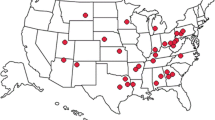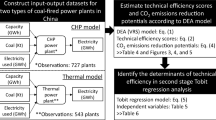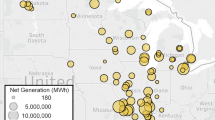Abstract
Analyses of the CO2 mitigation potential of increasing the efficiency of existing U.S. coal-fired power plants have indicated that significant CO2 emissions could be avoided if the efficiency of existing plants could be improved. This paper expands the analysis and estimates the potential economic and employment impacts of engaging in an U.S.-wide efficiency improvement program. Specifically, this study: (1) Discusses the factors affecting the operating efficiency of coal-fired power plants; (2) Identifies feasible efficiency improvements to existing coal-fired power plants; (3) Estimates the costs of coal power plant efficiency improvements; (4) Estimates the costs of a widespread coal power plant efficiency improvement (CPPEI) program; (5) Assesses the potential impacts of the CPPEI program, including the annual jobs created by the CPPEI program, the permanent operations and maintenance (O&M) jobs created by the CPPEI program, and the potential occupational impacts; (6) Evaluates the advantages and disadvantages of two CPPEI program options; and (7) Discusses the broader economic and employment implications of the program.



Similar content being viewed by others
References
R.R. Richwine, Power plant performance improvement: raising the benchmark. Presented at the World Energy Council—IEA G8 Cleaner Fossil Fuels Workshop, 17–18 January 2008
D.K. Agrawal, M.K.S. Kutty, Sustainable performance improvement in thermal power plants. Center for Power Efficiency & Environmental Protection, February 20, 2009; National Energy Technology Laboratory. “Increasing Power Plant Efficiency: Lignite Fuel Enhancement,” September 2008; APEC Energy Working Group, Expert Group on Clean Fossil Energy. “Costs and Effectiveness of Upgrading and Refurbishing Older Coal-Fired Power Plants in Developing APEC Economies,” Energy Working Group Project EWG 04/2003T, June 2005
Electric Power Research Institute, “CO2 Emissions Reduction Through Heat Rate Optimization for Advanced Coal-Fired Power Plants,” 2009; Ferrer, Albert, and Yan Kishinevsky. “Green Strategies for Aging Coal Plants: Alternatives, Risks, and Benefits,” Power Engineering, July 2008; Nichols, Chris, Gregson Vaux, Connie Zaremsky, James Murphy, and Massood Ramezan. Reducing CO 2 Emissions by Improving the Efficiency of the Existing Coal-fired Power Plant Fleet, National Energy Technology Laboratory, DOE/NETL-2008/1329, July 23, 2008; Tirabaschi, Marco, and Maurizio De Francesco. “Improving Plant Efficiency Using Predictive Maintenance,” Power Engineering Magazine, November 2008; National Energy Technology Laboratory. “Reducing CO2 Emissions and Maintaining Electricity Generation Through Efficiency Improvements at Existing Coal-fired Power Plants,” 2008; Ferrer, Albert, and George Keller. “Small-Buck Change Yields Big-Bang Gain,” Power Engineering, July 2007; National Petroleum Council. “Power Plant Efficiency Outlook: Power Plant Efficiency,” Working Document of the NPC Global Oil and Gas Study, July 18, 2007
National Energy Technology Laboratory, Clean Coal Demonstrations, 2009; National Energy Technology Laboratory. “Retrofitting Coal-Fired Power Plants for Carbon Dioxide Capture and Sequestration—Exploratory Testing of NEMS for Integrated Assessments,” DOE/NETL-2008/1309, January 18, 2008; Bellman, David K. “Power Plant Efficiency Outlook,” Working Document of the NPC Global Oil and Gas Study, July 18, 2007; Blankinship, Steve. “So You Want to Build a Power Plant,” Power Engineering, September 2007; Bohm, Mark C., Howard J. Herzog, John E. Parsons, and Ram C. Sekar. “Capture-Ready Coal Plants—Options, Technologies, and Economics,” International Journal of Greenhouse Gas Control, Volume 1 (2007), pp. 113–120; Rigdon, Robert and Miles, Kevin. “The Cleaner Coal Option,” Power Engineering International, July 2006
U.S. Energy Information Administration, Annual Energy Outlook 2011 With Projections to 2035, DOE/EIA-0383, March 2011
Management Information Services, Inc., Economic and employment impacts of increased efficiency in existing coal-fired power plants. Report prepared for the U.S. Department of Energy, National Energy Technology Laboratory, DOE/NETL-41817M4462, June 2009
National Research Council, New source review for stationary sources of air pollution. Committee on Changes in New Source Review Programs for Stationary Sources of Air Pollution, 2006; List, John A, Daniel, Daniel L. Millimet, and Warren McHone. “The Unintended Disincentive in the Clean Air Act,” Advances in Economic Analysis and Policy, Vol. 4, No 2 (2004), pp. 1–26
Management Information Services, Inc. Literature Review of Employment Impact Studies of Power Generation Technologies, report prepared for the National Energy Technology Laboratory, DOE/NETL-402/041309, April 2009. BBC Research and Consulting. Employment and Other Economic Benefits from Advanced Coal Electric Generation with Carbon Capture and Storage. Report prepared for the Industrial Union Council, AFL-CIO; the International Brotherhood of Boilermakers, Iron Ship Builders, Blacksmiths, Forgers, and Helpers; the International Brotherhood of Electrical Workers; the United Mine Workers of America; and the American Coalition for Clean Coal Electricity, Denver, Colorado, February 2009; Bergeron, Lisa, and John Lewis. The Economic Impacts of an Electric Power Generation Facility in Illinois, Regional Development Institute, Northern Illinois University, May 2007; Consumers Energy. Economic Impact Study of Consumers Energy’s Planned Expansion of the Karn/Weadock Generating Complex in Michigan, 2007; Considine, Tim. Coal: America’s Energy Future, Volume II, “Appendix: Economic Benefits of Coal Conversion Investments,” prepared for the National Coal Council, March 2006; Rose, Adam, and Dan Wei. The Economic Impacts of Coal Utilization and Displacement in the Continental United States, 2015, report prepared for the Center for Energy and Economic Development, Inc., Alexandria, Virginia, the Pennsylvania State University, July 2006; National Energy Technology Laboratory. Sales and Benefits of Technology from Clean Coal Demonstration Projects. 2006
S. Helper, The high road for U.S. manufacturing. Issues in Science and Technology, Winter 2009; Manufacturing Business Technology. April 23, 2009. www.mbtmag.com; Fraser, Shannon, and Stefan Osborne. Potential Exports of U.S. Clean Coal Technology Through 2030, U.S. Department of Commerce, International Trade Administration, November 2007
Author information
Authors and Affiliations
Corresponding author
Rights and permissions
About this article
Cite this article
Bezdek, R.H., Wendling, R.M. Economic, Environmental, and Job Impacts of Increased Efficiency in Existing Coal-Fired Power Plants. J Fusion Energ 32, 215–220 (2013). https://doi.org/10.1007/s10894-012-9556-y
Published:
Issue Date:
DOI: https://doi.org/10.1007/s10894-012-9556-y




